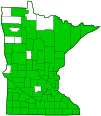Eastern Cottontail
(Sylvilagus floridanus)
Conservation • Description • Habitat • Ecology • Distribution • Taxonomy
Conservation Status |
|||
| IUCN Red List | LC - Least Concern |
||
| NatureServe | N5 - Secure SNR - Unranked |
||
| Minnesota | not listed |
||
Description
Eastern Cottontail is the smallest of Minnesota’s Leporidae, weighing 2 to 4 pounds at maturity.
Mearns’s Eastern Cottontail (Sylvilagus floridanus) is rusty-brown in color.
Nebraska Cottontail (Sylvilagus floridanus similis) is gray.
Size
Total length: 16″ to 19″
Tail: 1¼″ to 2½″
Sign
Similar Species
Snowshoe Hare (Lepus americanus), found in northern Minnesota, is slightly larger than the Eastern Cottontail. It is uniformly dark brown in the summer and turns white in the winter.
White-tailed Jackrabbit (Lepus townsendii) is much larger, weighing 5¾ to 9½ pounds at maturity. It turns white in the winter.
Habitat
Eastern Cottontail is found in a wider variety of habitats than any other cottontail species. Any habitat that includes well-distributed, dense shrubs for escape cover interspersed with open, grassy areas is ideal for this species. These include farmlands, old fields, pastures, hedgerows, orchards, brushy clearings, open woods, wooded thickets, edges of woodlands, and suburban areas with adequate cover.
Ecology
Behavior
Lifespan
3 to 5 years
Life Cycle
Food
In the spring, summer, and fall, Eastern Cottontails feed on a wide variety of plant matter, including grasses (about half of it’s diet), clover, wild strawberry, cultivated and wild flowers, and many types of cultivated crops.
During the winter months they feed on twigs, bark and buds of oak, dogwood, sumac, maple and birch. They may girdle fruit trees and ornamental shrubs.
Distribution |
||
|
Sources Biodiversity occurrence data published by: Minnesota Biodiversity Atlas (accessed through the Minnesota Biodiversity Atlas Portal, bellatlas.umn.edu, 12/12/2025). Timm, R. M. 1975. Distribution, natural history, and parasites of mammals of Cook County, Minnesota. Occasional Papers, Bell Museum of Natural History, University of Minnesota 14:1–56. Hazard, Evan B. 1982. The Mammals of Minnesota. University of Minnesota Press, Minneapolis, Minnesota. 280 pp. |
|
| 12/12/2025 | ||
Mearns’s Eastern Cottontail (S. f. mearnsi) is found throughout the state except for the northeast corner and the western portion of the northwestern counties. Nebraska Cottontail (S. f. similis) range extends into Minnesota only in the western portion of the northwestern counties. |
||
Occurrence |
||
Common |
||
Taxonomy
Class
Subclass
Theria
Infraclass
Placentalia (Placental Mammals)
Magnorder
Boreoeutheria
Superorder
Euarchontoglires (Primates, Rodents, and Allies)
Order
Lagomorpha (Lagomorphs)
Family
Leporidae (Hares and Rabbits)
Genus
Sylvilagus (Cottontail Rabbits)
Subordinate Taxa
Some major global databases (GBIF, ITIS, Catalogue of Life, and Discover Life) currently list Sylvilagus floridanus with no subspecies, while others (Mammal Species of the World and iNaturalist) retain the traditional set of many subspecies. The move toward subspecies-free treatments in the former group is not the result of a formal abolition in the scientific literature, but rather reflects a preference for simplified “species-only” listings unless subspecies are strongly supported by modern genetic data.
Recent studies indicate that most eastern and midwestern U.S. populations are too intermixed—largely due to extensive translocations in the 19th and 20th centuries—to support clear subspecific boundaries. In contrast, some peripheral or isolated populations, especially in Mexico, Central America, and certain islands, have been elevated to full species in some treatments.
Alta Mira Cottontail (Sylvilagus floridanus connectens)
Black-naped Rabbit (Sylvilagus floridanus continentis)
Chiapas Cottontail (Sylvilagus floridanus chiapensis)
Curaçao Cottontail (Sylvilagus floridanus nigronuchalis)
Eastern Cottontail (Sylvilagus floridanus llanensis)
Eastern Cottontail (Sylvilagus floridanus macrocorpus)
Eastern Cottontail (Sylvilagus floridanus mallurus) ![]()
Florida Cottontail (Sylvilagus floridanus floridanus) ![]()
Margarita Cottontail Rabbit (Sylvilagus floridanus margaritae)
Mearns’s Eastern Cottontail (Sylvilagus floridanus mearnsi) ![]()
![]()
Micco Cottontail Rabbit (Sylvilagus floridanus ammophilus)
Nebraska Cottontail (Sylvilagus floridanus similis) ![]()
![]()
Oklahoma Cottontail (Sylvilagus floridanus alacer) ![]()
Orizaba Cottontail (Sylvilagus floridanus orizabae)
Russet Cottontail (Sylvilagus floridanus russatus)
Smiths Island Cottontail rabbit (Sylvilagus floridanus hitchensi)
Tehuantepec Cottontail (Sylvilagus floridanus aztecus)
Texas Cottontail (Sylvilagus floridanus chapmani) ![]()
Synonyms
Lepus floridanus
Lepus orizabae
Lepus russatus
Lepus sylvaticus
Common Names
Andean Rabbit
Eastern Cottontail
Visitor Photos
Share your photo of this mammal.
This button not working for you?
Simply email us at info@MinnesotaSeasons.com.
Attach one or more photos and, if you like, a caption.
Lane Keller |
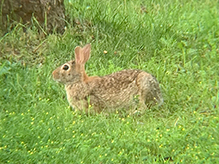 |
Near the Jacob V. Brower Visitor Center. |
Joan Thilges |
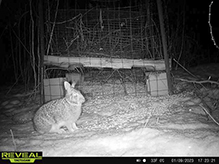 |
Our land is located in Newburg Township, Fillmore County, MN We have trail cameras on our wildlife feeders and I have noticed in all the images of rabbits they have quite small ears, some even smaller than the raccoons that visit the feeder. Yet the photos on your site and elsewhere show rabbits with longer ears. Is this a regional variation or are ours not Eastern Cottontail? |
Wayne Rasmussen |
||
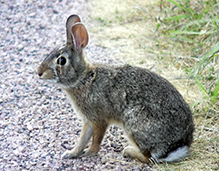 |
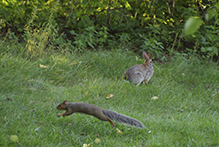 |
|
Bill Reynolds |
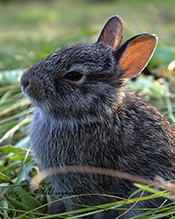 |
MinnesotaSeasons.com Photos
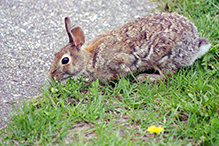 |
 |
|
Mearns’s Eastern Cottontail |
Mearns’s Eastern Cottontail |
|
 |
||
Mearns’s Eastern Cottontail with cottontail rabbit papilloma virus (CRPV) |
|

Slideshows
Sylvilagus floridanus (Eastern Cottontail)
Allen Chartier
Eastern Cottontail
Dan Dzurisin
Eastern Cottontail Rabbit
Gerald (Wayne) Prout

Visitor Videos
Share your video of this mammal.
This button not working for you?
Simply email us at info@MinnesotaSeasons.com.
Attach a video, a YouTube link, or a cloud storage link.
Other Videos
Eastern Cottontail Rabbit (Leporidae: Sylvilagus floridanus)
Carl Barrentine

Visitor Sightings
Report a sighting of this mammal.
This button not working for you?
Simply email us at info@MinnesotaSeasons.com.
Be sure to include a location.
Joan Thilges
1/9/2023

Location: Newburg Township, Fillmore County, MN
Our land is located in Newburg Township, Fillmore County, MN We have trail cameras on our wildlife feeders and I have noticed in all the images of rabbits they have quite small ears, some even smaller than the raccoons that visit the feeder. Yet the photos on your site and elsewhere show rabbits with longer ears. Is this a regional variation or are ours not Eastern Cottontail?
John Valo
1/11/2023
Only three rabbit species occur in Minnesota. Snowshoe rabbit is a northern species and does not occur in the southern third of the state. White-tailed Jackrabbit has even larger ears with a black tip. The rabbit in this photo, if it is not domestic, is an Eastern Cottontail.
When a rabbit alerts to a sound, it will "prick up its ears". This may account for the difference in apparent size of rabbit ears in photos on this site and elsewhere.
Janet M Diehl
1/18/2018
Location: Episcopal Homes of MN at University W. & Fairview
I live at Episcopal Homes of MN at University W. & Fairview. We have some resident wild rabbits which I think are Eastern Cottontail. In the warmer months I often see them eating the clover and grass on the lawns by our buildings at dusk.
I see them only on the inside of the connected complex of buildings – not on the lawns on the street sides of our buildings. Nor do I see them in the small city park next to Episcopal Homes. All this makes me think they are confined or trapped by our continuous buildings. The only real exit is on to University.
My question is: How do they survive in the winter? I see them out occasionally at dusk in the snow or where the snow is pushed aside or bare spots under shrubs & trees, but even that doesn’t seen like enough to sustain them through the winter. I found a dead bunny last spring next to our building by some shrubs.
Is there any thing I can do to support their life? Food? Plants? Hay? Shelter? etc. Things to avoid? I have read quit a bit on line, but my questions are not answered. Some parts of your website I could not open.
John Valo
1/19/2018
Three Eastern Cottontails live in or near my yard. They have a tough time finding enough food in the winter. I buy Purina Rabbit Chow from Fluegel's in Rosemount. Pet food stores should carry it also. If you want to feed your rabbits, you might put a half cup of it some place where
- they can find it;
- it will not be disturbed or covered with snow; and
- it is easy for you to get to every day.
For me, that place is by a basement exit under an outdoor, second floor deck. I make three small piles, well-spaced, a third cup each, so the three rabbits can all eat at the same time without fighting over the food.
John Valo
6/20/2016
Note the gray fur color. This is a Nebraska cottontail (S. f. similis).





